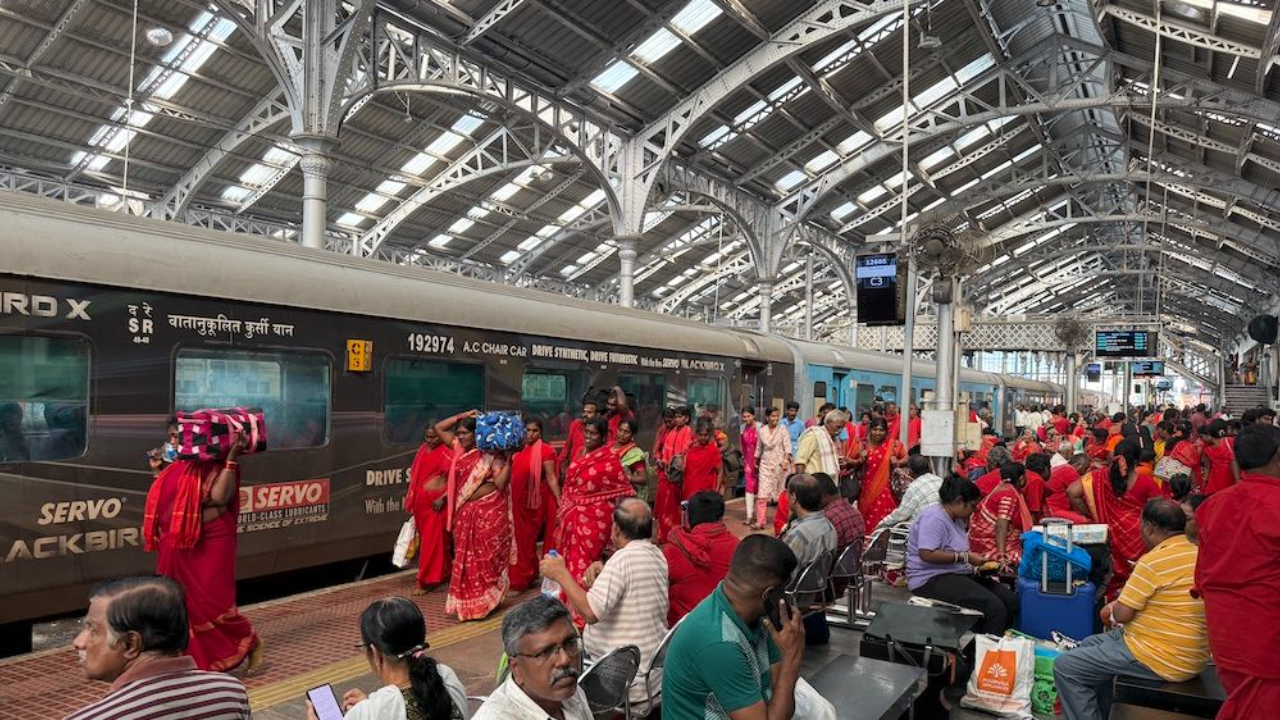LIBERATE YOUR VOICE!
The Value Of Vedic Chanting

In 2018, an extraordinary article in the Scientific American on the "Sanskrit Effect" caught my attention. A neuroscientist studying MRI scans discovered, after 14 years of researching the brains of Vedic pandits, that memorizing ancient mantras increases the size of brain regions associated with cognitive function.
For decades, I have been teaching around the world that Vedic chanting is not about chanting in any way we want, nor is it about freedom of expression or creativity. Instead, it is about discovering the experience of the Rishis, the great seers of the Vedas. Now, we know that there is science behind the process that can assist us in a very worldly way, pun intended.
Traditionally, Vedic mantras were chanted for the well-being of the world and the well-being of all. Through this body of research, we have come to understand that chanting Vedic mantras in accordance with their unique rules can be beneficial. The personal benefits are even more significant than their altruist...
What It Takes To Explore Tantra

At the core of delving into Tantra is the essential element of a curious mind. This insatiable desire to discover and understand serves as the very foundation of your exploration. Central to this tradition of Tantra is the concept of gnosis, which transcends mere knowledge. To appreciate what gnosis embodies, it's vital to recognize that it represents a profound and transformative way of knowing, distinct from conventional understanding.
This distinction is crucial because engaging with Tantra solely as an academic exercise—where one merely reads about the principles and practices—will not usher in an authentic experience. While we may accumulate factual information about Tantra from a safe distance, this detached perspective will not immerse anyone in the depth and richness of genuine Tantric practice.
For a proper understanding of Tantra and to grasp its essential nature, we must engage in a more experiential form of knowing, which calls for us to step beyond mere observation and a...
Hindu Trimurti: Brahma, Vishnu, Shiva

The Trimurti is a concept in Hinduism representing the three primary deities: Brahma (the creator), Vishnu (the preserver), and Shiva (the destroyer). It is important because it embodies the cyclical nature of existence, highlighting the interconnectedness of creation, maintenance, and destruction within the universe.
There are several expressions of Trinitarian sensitivity in Hinduism, some of which are esoteric and others within a particular orthodoxy. For example, Sat-chid-ananda, the concept of being-knowledge-bliss, is a profound expression of this mystery. We will adopt the view that stems from the notion that the different powers discerned in contemplating the universe—like the creation of our universe—are associated with three distinct aspects of the divine mystery.
Brahma, often depicted with four heads, symbolizing his all-encompassing knowledge, is considered the creator of the universe and all beings. Vishnu preserves order and balance in the universe, even intervening ...
Singing As Meditation

Indian music is essentially vertical in nature, meaning that it is internal and reflective of a drawing inward. Like the Eastern culture and religion, it is introverted. Eastern religions emphasize the importance of introspection and self-discovery, encouraging individuals to explore the inner reality and mystery of their being. Eastern music facilitates this process.
The power and beauty of this vertical music lie in melody, which is the relationship of successive notes. Melody is a means of connecting the human with the Divine. It operates through the psychic levels of an intermediate world that is difficult to define, as it transcends the boundaries of everyday existence and consciousness. It is a world of the unconscious, of dreams and deep moods, images and sounds, of the inner senses—those mystical dimensions of the human psyche that are either overdeveloped or underdeveloped in most of us.
Indian music, and all contemplative music, strives to balance these dimensions as it u...
A Flame On The Divine Breath

I first met Andrew in Lexington, Kentucky, in the mid-2000s when he joined the faculty of Matthew Fox's creation spirituality programs. We stayed at the same inn and got to know each other a bit. I remember his razor-sharp wit when someone asked him if the wallpaper reminded him of the inns in England, and he said, "Yes, except this one's on drugs!" Over the years, as he came to teach at the university in Oakland, we would meet, and sometimes, he would visit us at home.
Andrew is, above all, a mystic of the highest order. What is extraordinary about him is that he has the words for the experience. When it comes to mysticism, many people will say that it is difficult to describe. Not Andrew. Born in Coimbatore, India, and educated at Oxford, he became the youngest fellow at Oxford and later one the most influential spiritual voices in the world. His fiery, passionate way of speaking about mysticism became his trademark.
When Asha and I left India, we bid farewell to our beloved ment...
Shanti Mantras And The Upanishads

Shanti mantras are the perfect segue into the Vedic experience and the development of spiritual consciousness that culminates in the Upanishads. Today, having a meaningful way to pray for the peace and well-being of the world carries a sense of urgency as a result of current geopolitics and conflicts. In addition to our prayers and affirmations in our thinking language, mantras work more effectively in this context because their vibrations differ from those of everyday speech, even though mantras are themselves a form of speech, albeit not ordinary speech, but sacred speech.
The chanting of Shanti Mantras is the recitation of peace prayers before the teaching of the Upanishads, which are the loftiest teachings from the Vedas, influencing Schopenhauer and many great Western thinkers. The Upanishads are the culmination of the Vedas, which is why they are known as Vedānta: the anta, meaning "end," of the Vedas. Chronologically, the Upanishads occur at the end of the Vedic period.
You ha...
The Relevance of Shaktiism Today

Most of us, myself included, have been shaped by a theology dominated by the male perspective, where the supreme Godhead is typically depicted as male. This cultural norm is reflected in our language, as we often refer to God as 'he'.Shaktiism, however, offers a unique and powerful alternative.
Shaktiism, the source of Ananda Bhairava, is a form of Tantra that celebrates the ultimate reality as feminine, a powerful source of inspiration for women, offering them a unique path to empowerment.
Ananda Bhairava Tantra offers men and women a way to connect to the direct experience of what it means to know, see, seek, and be in a relationship with ultimate reality as feminine instead of masculine.
This approach does not obliterate the need to relate to ultimate reality through male references and that archetype of masculinity.
Shaktiism, Sri Vidya, and Ananda Bhairava provide a platform for all, regardless of gender, to balance the excessive masculine references in our spirituality, foste...
On A Train With Us In India

We used to embark on journeys to India with our students as pilgrims, searching for what we would refer to as the other half of the soul, a concept inspired by the profound writings of our esteemed mentor, Bede Griffiths. Our recent trip to India was especially poignant; it marked the first time in 26 years, since 1999, that we ventured without our students.
Although our intentions were different this time, we carried forward many of the invaluable lessons and practices we had cultivated throughout our pilgrimages. Along the way, we reminisced about some of those transformative experiences, and there’s one particular story we believe deserves to be shared.
If you had the opportunity to travel with us on a train through India, you would likely feel a wave of nostalgia while watching this video. There were numerous moments when we longed for the camaraderie of our fellow pilgrims, sharing in the depth and joy of the journey alongside us.
However, we must be clear: we have decided not ...
Abode Of The Accomplished Ones

"Take only memories, leave only footprints."
— Chief Seattle.
In a small village not far from the culturally rich town of Pudukottai in Tamil Nadu, there is a remarkable spiritual vibration that endures to this day.
The town dates back 2,000 years to a period when Jainism was quite prominent in the region. The Jains are ascetic monks who practice extreme forms of deprivation, as evidenced by their hard stone beds carved out of rock. Similar to Buddhists, they beg for food in a nearby village and limit their intake to one meal a day. They also spend long periods in silence and meditation.
“Wherever you go becomes a part of you somehow.”
― Anita Desai
What surprised me was the security guard's knowledge of Nada Yoga. He demonstrated this by creating resonant tones inside the rock temple, once used by the monks. He accomplished this using a ventriloquist-like technique, producing sounds from various spots outside the main shrine. It was nothing short of extraordinary. He then ...
Keys To Invoking Lakshmi

In Tantric mantra practice, the keys refer to specific elements that can enhance the effect of mantras. These keys are direction, bija, and the deity's name. Each of these elements plays a crucial role in the effectiveness of the practice, and understanding them can significantly improve your Tantric mantra practice.
Our experience of teaching Tantric practice over four decades has led us to a significant realization: the clarity of our perspective is as important as our actual practices. This understanding can enlighten and empower you, as it reveals that if the underlying message of our practice is muddled, no amount of effort will yield the desired results, leading to disappointment and frustration.
In this blog, we delve into invoking the goddess Lakshmi for abundance. Amidst the plethora of information (and misinformation) out there, the application of the 3 keys, by themselves, can indeed help with our manifestation process, reassuring and boosting our confidence in the spiri...


